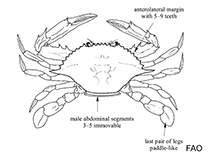Callinectes toxotes Ordway, 1863
Giant swimcrab| Native range | All suitable habitat | Point map | Year 2050 |

|
| This map was computer-generated and has not yet been reviewed. |
| Callinectes toxotes AquaMaps Data sources: GBIF OBIS |
Google image | No image available for this species;
drawing shows typical species in Portunidae.
Classification / Names आम नाम | उपशब्द | CoL | ITIS | WoRMS
Malacostraca | Decapoda | Portunidae
Environment: milieu / climate zone / गहराई सीमा / distribution range पारिस्थितिकी
; गहराई सीमा 0 - 77 m (संदर्भ 112850), usually ? - 30 m (संदर्भ 112850). Tropical; 18°C - 34°C (संदर्भ 112850); 24°N - 34°S, 112°W - 77°W
Distribution देश | ऐफ ऐ ओ क्षेत्र | Ecosystems | संयोग | भूमिका
Eastern Pacific: From Cape San Lucas, Baja California and Sinaloa (Río Piaxtla), Mexico to mouth of river Tumbes, Peru and Juan Fernandez Island, Chile.
Length at first maturity / आकार / Weight / Age
परिपक्व अवधि: Lm ? range ? - ? cm Max length : 16.0 cm CW पुल्लिंग / अलिंग; (संदर्भ 121685)
Life cycle and mating behavior परिपक्व अवधि | पुनरुत्पत्ति | मछलीऔ का अंडे देना | Eggs | Fecundity | Larvae
Main reference
संदर्भ | संयोजक | सहयोगीयो
Taylor, M.H., M. Wolff, F. Vadas and C. Yamashiro 2008 Trophic and environmental drivers of the Sechura Bay ecosystem (Peru) over an ENSO cycle. Helgol Mar Res 62 (Suppl 1):S15-S32. (संदर्भ 92517)
IUCN Red List Status
(संदर्भ 130435: Version 2025-1)
CITES status (संदर्भ 108899)
CMS (संदर्भ 116361)
Threat to humans
Human uses
मात्स्यिकी: व्यापारिक
| FishSource |
साधन
अधिक जानकारी
इंटरनेट स्रोत
BHL | BOLD Systems | CISTI | DiscoverLife | FAO(Publication : search) | Fishipedia | GenBank (genome, nucleotide) | GloBI | Gomexsi | Google Books | Google Scholar | Google | PubMed | Tree of Life | Wikipedia (Go, खोज) | Zoological Record



